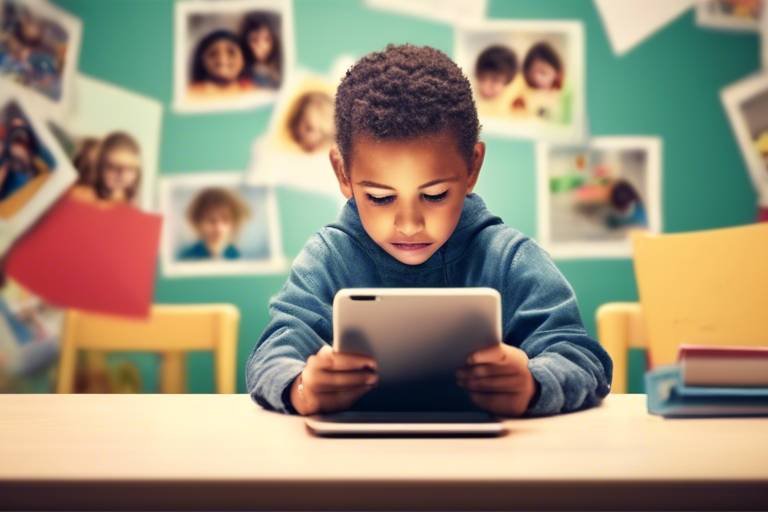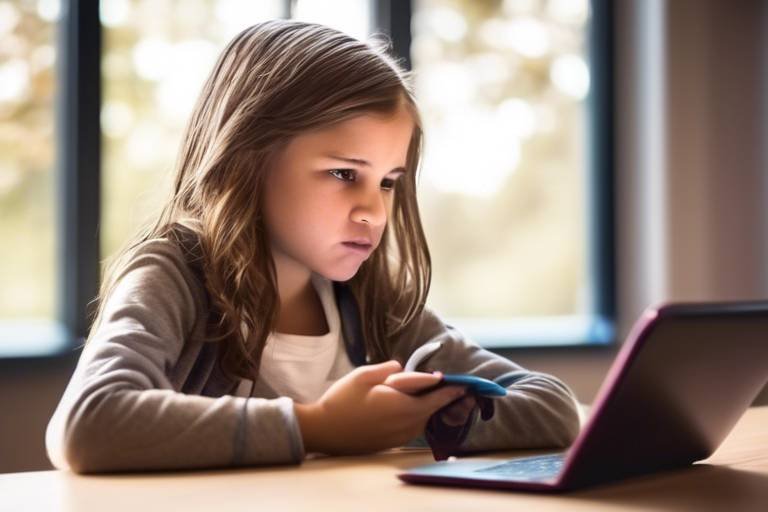Guidelines for Your Child's Screen Use
In today's digital age, managing your child's screen time can feel like walking a tightrope. With devices everywhere—tablets, smartphones, and televisions—it's crucial for parents to find that sweet spot between allowing technology use and encouraging other essential activities. This article provides essential guidelines for parents to manage their child's screen time effectively, ensuring a healthy balance between technology use and other important activities in their lives.
So, what exactly is screen time? It encompasses any time spent in front of a screen, whether it's for educational purposes or just plain entertainment. Think about all the screens your child interacts with: TVs, computers, tablets, and smartphones. Each type of screen can have a different impact on your child's development, behavior, and social skills. The way children engage with screens can shape their learning experiences and social interactions. For instance, while educational shows can enhance learning, excessive exposure to passive entertainment might hinder social skills. It's all about how and what they consume!
Health experts have weighed in on the topic of screen time, providing age-appropriate recommendations that emphasize moderation and balance. The American Academy of Pediatrics suggests that children aged 2 to 5 should have no more than one hour of high-quality programming each day. For older children, it's not just about limiting time but also ensuring that screen use doesn't interfere with sleep, physical activity, and other healthy behaviors. The key takeaway? Balance is crucial!
When it comes to toddlers, their unique developmental needs require special attention. The recommended screen time limit for this age group is one hour per day of high-quality programming. But what does "high-quality" mean? It means content that is educational, engaging, and age-appropriate. Parents should focus on shows that promote learning and interaction, rather than mindless entertainment.
Understanding the difference between educational and entertainment content is vital. Educational content can help toddlers learn new words, understand basic concepts, and even develop problem-solving skills. In contrast, entertainment content often lacks educational value and can lead to passive viewing habits. By choosing educational shows, parents can ensure that screen time contributes positively to their child's development.
Interactive screen time can be a game-changer for toddlers. Think of educational apps and games that encourage learning through play. These interactive experiences not only engage children but also promote critical thinking and creativity. For example, apps that allow toddlers to solve puzzles or create art can be both fun and educational. Just remember to balance this with plenty of physical playtime!
As children grow older and enter school, their screen time needs evolve. It's essential to establish guidelines that promote a healthy balance between educational use and recreational activities. This age group can benefit from using screens for homework and research, but it's equally important to encourage physical activities, outdoor play, and face-to-face interactions with peers. Parents should foster an environment where technology enhances learning rather than detracts from it.
Establishing clear screen time rules at home is a vital step in managing your child's technology use. Start by discussing the importance of screen time and its potential effects on their health and social life. Setting boundaries can include specific times for screen use, such as no screens during meals or before bedtime. This helps create a routine that encourages responsible technology use.
A family media plan can be an effective tool for guiding screen time. This plan should outline screen time limits, content guidelines, and family activities that promote quality time together. Here’s a simple structure you can follow:
| Age Group | Recommended Screen Time | Content Type |
|---|---|---|
| Toddlers (2-5 years) | 1 hour/day | Educational content |
| School-aged children (6-12 years) | 1-2 hours/day | Educational and recreational content |
| Teens (13-18 years) | 1-2 hours/day | Balanced use of educational and entertainment content |
Monitoring your child's screen use is crucial. This doesn't mean hovering over them while they watch their favorite shows, but rather having open conversations about what they are watching and playing. Utilize tools and techniques to ensure they engage with appropriate content and maintain healthy habits. Consider using parental control apps that can help you manage screen time and monitor content, keeping your child safe online.
- How can I encourage my child to take breaks from screens? Try incorporating fun physical activities or family games that require movement to make breaks enjoyable.
- What should I do if my child is resistant to screen time limits? Discuss the reasons behind the limits and involve them in creating a media plan to foster understanding and cooperation.
- Are there specific apps you recommend for toddlers? Look for apps that focus on learning letters, numbers, and problem-solving skills, such as ABCmouse or Endless Alphabet.

Understanding Screen Time
In today's digital age, screen time has become an integral part of our daily lives, especially for children. But what exactly does "screen time" entail? It refers to the time spent using devices with screens, such as smartphones, tablets, computers, and televisions. While technology can be a great tool for learning and entertainment, it's crucial to understand its impact on children's development, behavior, and social skills.
First, let's break down the different types of screens that children interact with:
- Television: Often used for entertainment and passive viewing.
- Tablets and Smartphones: Devices that allow for interactive engagement, including games and educational apps.
- Computers: Used for both learning and recreational purposes, including social media and online gaming.
Research indicates that excessive screen time can lead to various issues, including obesity, sleep problems, and even behavioral issues. Children who spend too much time on screens might miss out on essential activities like physical play and face-to-face interactions, which are crucial for developing social skills. In fact, studies show that children who engage in more screen time often struggle with attention spans and may find it harder to concentrate in school.
Moreover, the content consumed during screen time plays a significant role in its effects. Passive consumption, like watching TV shows, can lead to a lack of engagement and critical thinking. On the other hand, interactive screen time, such as educational games or apps that encourage problem-solving, can foster creativity and cognitive development. This duality emphasizes the importance of not just the quantity of screen time but also the quality.
As parents, it's vital to be aware of how screen time shapes your child's world. Are they using screens to connect with friends, or are they isolating themselves? Are they learning new skills, or are they just consuming mindlessly? By understanding these dynamics, you can help your child navigate their screen time in a way that promotes a healthy balance with other essential activities in their lives.

Recommended Screen Time Limits
When it comes to screen time, the age of your child plays a crucial role in determining how much exposure they should have. Experts from organizations like the American Academy of Pediatrics (AAP) have established some guidelines that can help parents navigate this digital landscape. It's essential to understand that while screens can be a valuable tool for learning and entertainment, moderation is key to ensuring a healthy balance in your child's life.
For infants and toddlers, the recommendation is quite clear. Children aged 0-18 months should avoid screen time, except for video chatting. This is because their brains are rapidly developing, and face-to-face interactions are far more beneficial. As they grow into toddlers (ages 18 months to 2 years), parents can introduce high-quality educational content, but it's crucial to watch together and discuss what they see. This shared experience can enhance learning and help toddlers make sense of the world around them.
As children move into the preschool years (ages 2-5), the AAP suggests limiting screen use to 1 hour per day of high-quality programming. This is the stage where children begin to develop their social skills, and excessive screen time can hinder their ability to interact with others. Instead, parents should encourage activities that promote creativity and physical activity, like playing outside or engaging in arts and crafts. Remember, screens should never replace real-world experiences!
For school-aged children (ages 6 and older), the recommendations shift slightly. The focus here is on balancing screen time with other essential activities, such as homework, physical play, and family time. While there isn't a strict limit, parents are encouraged to set consistent boundaries. For example, you might consider implementing a 2-hour daily limit for recreational screen time. This can include video games, social media, and streaming shows. The goal is to ensure that screens are just one part of a well-rounded routine.
To summarize, here’s a quick look at the recommended screen time limits:
| Age Group | Recommended Screen Time | Notes |
|---|---|---|
| 0-18 months | Avoid, except for video chatting | Focus on face-to-face interactions |
| 18 months - 2 years | High-quality educational content | Watch together to enhance learning |
| 2-5 years | 1 hour per day | Encourage physical play and creativity |
| 6 years and older | Balance with other activities | Consider a 2-hour recreational limit |
Ultimately, the key is to establish a routine that works for your family. Engage in conversations about what your child is watching and playing, and encourage them to share their thoughts and feelings about the content. By doing so, you're not just monitoring their screen time; you're also fostering critical thinking and communication skills. So, go ahead, set those limits, and watch as your child thrives both on and off the screen!

Screen Time for Toddlers
When it comes to , the conversation can feel a bit overwhelming for parents. After all, we live in an age where screens are everywhere—from tablets and smartphones to televisions and computers. So, how do we navigate this digital landscape while ensuring our little ones are not only safe but also thriving? The key lies in understanding the unique needs of toddlers and establishing healthy screen time limits that promote their development.
Experts recommend that toddlers aged 2 to 5 should have no more than one hour of high-quality programming each day. But what does “high-quality” mean? It refers to content that is educational, engaging, and age-appropriate. Think of it as the difference between a balanced diet and junk food; just as we wouldn’t feed our toddlers nothing but sweets, we shouldn’t let them binge on mindless content either. Quality matters!
It's also essential to consider the types of activities toddlers engage in during their screen time. Interactive screen time, such as educational apps and games, can be particularly beneficial. These activities can stimulate a child's curiosity and encourage them to explore new concepts. For example, apps that teach basic math or literacy through fun games can be a great way to combine learning with play. Remember, toddlers learn best through play and exploration, so interactive content can be a valuable tool in their development.
However, it’s not just about what they watch; it’s also about how they watch it. Co-viewing with your child can enhance their understanding and help you gauge their reactions to different content. Ask questions like, “What do you think will happen next?” or “Why do you think they did that?” This not only fosters a deeper connection but also encourages critical thinking. Plus, it’s a great way to bond with your little one over their favorite shows!
To help you make informed choices, here's a quick comparison of educational vs. entertainment content:
| Type of Content | Characteristics | Examples |
|---|---|---|
| Educational | Promotes learning, encourages problem-solving, and often incorporates interactive elements. | Sesame Street, PBS Kids, educational apps |
| Entertainment | Primarily for enjoyment, may not have educational value, often involves passive viewing. | Cartoons like Peppa Pig, animated movies |
In conclusion, while screens can be a wonderful tool for learning, moderation is key. By setting clear limits and focusing on high-quality content, you can help your toddler navigate the digital world in a way that supports their growth and development. Remember, the goal is to create a balanced lifestyle where screen time complements other essential activities like outdoor play, reading, and family interactions.
- How can I ensure my toddler is watching age-appropriate content? Check reviews and ratings from trusted sources like Common Sense Media, and always preview content before allowing your child to watch.
- What should I do if my toddler is addicted to screens? Gradually reduce screen time and introduce alternative activities that capture their interest, such as arts and crafts or outdoor play.
- Is it okay for toddlers to use screens for educational purposes? Yes, as long as the content is high-quality and you engage with them during their screen time.

Educational vs. Entertainment Content
When it comes to screen time for toddlers, understanding the distinction between educational and entertainment content is crucial for parents. Think of educational content as the nutritious vegetables on a child's plate—essential for growth and development—while entertainment content is akin to the sweet treats that, while enjoyable, should be consumed in moderation. The right balance can foster a love for learning while still allowing for some fun.
Educational content typically includes programs, apps, and games designed to teach toddlers specific skills, such as numbers, letters, and problem-solving. These resources often incorporate interactive elements that engage children actively, making learning feel like play. For example, shows like Sesame Street or apps like Endless Alphabet not only entertain but also educate, helping children develop cognitive and social skills.
On the other hand, entertainment content is primarily aimed at keeping toddlers engaged and amused. While not inherently bad, it's essential to monitor the type of entertainment they consume. Programs like Peppa Pig or Bluey provide wholesome entertainment, but excessive viewing can lead to passive consumption, where children are not actively engaging with the material. This can hinder their ability to develop critical thinking and social interaction skills.
To help parents navigate these choices, here’s a simple comparison:
| Type of Content | Examples | Benefits |
|---|---|---|
| Educational | Sesame Street, Endless Alphabet | Enhances cognitive development, encourages active participation |
| Entertainment | Peppa Pig, Bluey | Provides enjoyment, promotes relaxation |
Ultimately, the key is to strike a healthy balance. Encourage your child to engage with educational content that challenges their minds while allowing for some downtime with entertainment shows that spark joy. By doing this, you’re not just filling their screen time with passive viewing but actively enriching their learning experience. So, the next time your toddler asks to watch something, consider whether it’s more of a learning opportunity or just a way to pass the time.
- How can I tell if a show is educational? Look for programs that promote learning through engaging characters, interactive elements, and age-appropriate content.
- Is it okay for my child to watch entertainment content? Yes, but moderation is key. Ensure that entertainment content is age-appropriate and balanced with educational programming.
- What are some good educational apps for toddlers? Apps like Endless Alphabet, ABCmouse, and Starfall are excellent choices that promote learning in a fun way.

Interactive Screen Time
When we think of screen time, we often picture children glued to their devices, passively consuming content. However, presents a whole different ball game! It's not just about watching; it's about engaging and learning in a fun way. Think of it as a vibrant playground where toddlers can explore, create, and interact with their environment through their screens. This type of screen time includes educational apps, games, and activities that encourage children to think critically and solve problems.
Research shows that interactive screen time can significantly enhance a child's learning experience. For instance, apps that promote language development or math skills can be incredibly beneficial. These tools often use colorful graphics and engaging characters that capture a child's attention, making learning feel like a game rather than a chore. This is crucial during the formative years when children are like sponges, soaking up information and skills that will serve them for a lifetime.
However, not all interactive content is created equal. It's essential to choose apps and games that are not only entertaining but also educational. Here are some key features to look for:
- Age-appropriate content: Ensure that the material is suitable for your child's developmental stage.
- Engagement: Look for apps that require active participation rather than passive watching.
- Learning outcomes: Choose programs that have clear educational goals, such as improving vocabulary or enhancing problem-solving skills.
Moreover, interactive screen time can foster social skills when children engage in multiplayer games or collaborative apps. This type of interaction can teach kids how to work as a team, communicate effectively, and even navigate conflicts—skills that are invaluable in today's world. Picture it as a digital version of a group project in school where everyone has a role to play, and together they achieve a common goal.
It's also important to remember that while interactive screen time has its benefits, moderation is key. Parents should encourage a healthy balance between screen engagement and other activities, such as outdoor play, reading, and family time. After all, the ultimate goal is to ensure that screen time is a tool for growth, not a substitute for real-world experiences.
In conclusion, interactive screen time can be a fantastic opportunity for toddlers to learn and grow, provided it is used wisely. By selecting high-quality, engaging content and ensuring it's part of a balanced routine, parents can help their children make the most of their screen time while also fostering a love for learning that extends beyond the digital world.
- What is interactive screen time? - Interactive screen time refers to engaging with content that requires active participation, such as educational apps and games.
- How much interactive screen time is appropriate for toddlers? - It's recommended that toddlers have limited screen time, with a focus on high-quality, interactive content.
- Can interactive screen time help with learning? - Yes! When chosen wisely, interactive screen time can enhance language skills, problem-solving abilities, and more.
- Should I monitor my child's interactive screen time? - Absolutely! Monitoring helps ensure that the content is appropriate and that screen time is balanced with other activities.

Screen Time for School-Aged Children
As children transition into the school-aged years, their relationship with screens becomes even more complex. At this stage, they are not only consuming content but also creating it, engaging with peers online, and often using screens for educational purposes. However, with this increased access comes the responsibility of managing screen time effectively. So, how do we strike the right balance? It's all about moderation and mindfulness.
According to health experts, school-aged children should ideally have no more than 1 to 2 hours of recreational screen time each day. This includes activities such as watching TV, playing video games, or browsing the internet for fun. But remember, it’s not just about the quantity of time spent in front of a screen; the quality of that time is equally important. Engaging with educational content can be beneficial, while mindless scrolling through social media can lead to negative outcomes.
To help parents navigate this screen time landscape, it's crucial to consider a few key factors:
- Content Quality: Encourage educational programs that promote learning and critical thinking. Shows like Sesame Street or apps designed for math and reading can enrich your child’s knowledge.
- Active Participation: Whenever possible, watch shows or play games together. This not only allows you to monitor what they are consuming but also turns screen time into a bonding experience.
- Balance with Physical Activity: Ensure that screen time does not replace physical play. Encourage your child to engage in outdoor activities or sports to maintain a healthy lifestyle.
Moreover, it's essential to introduce the concept of digital citizenship at this age. Teach your children about the importance of being responsible online, understanding privacy settings, and recognizing inappropriate content. A simple conversation about what is acceptable and what isn't can go a long way in helping them navigate the digital world safely.
Also, consider integrating technology into their daily routines in a way that complements their education. For instance, using educational apps for math practice or language learning can reinforce what they are learning in school. However, it’s vital to set clear boundaries around when and how screens are used. For example, establishing a rule that screens are turned off during family meals can foster better communication and connection.
Finally, don't forget to regularly review and adjust your screen time rules as your child grows. What works for a 6-year-old may not be suitable for a 10-year-old. Keeping an open dialogue with your child about their screen use and preferences can help you both stay on the same page, ensuring that technology serves as a tool for growth rather than a distraction.
Here are some common questions parents have regarding screen time for school-aged children:
- What are the best types of content for my child? Look for programs that are educational and promote creativity, such as documentaries, science shows, or interactive apps.
- How can I monitor my child's screen time effectively? Use parental controls available on most devices and set timers to help keep track of their usage.
- Should I allow screens in the bedroom? It’s generally best to keep screens out of bedrooms to encourage better sleep habits and reduce distractions.

Setting Screen Time Rules
Establishing screen time rules in your home is crucial for promoting a healthy relationship between your child and technology. Think of it as setting the boundaries of a playground; without them, kids might wander too far or get into trouble. The first step is to have an open conversation with your child about the importance of screen time limits. Explain that while screens can be fun and educational, too much time spent in front of them can lead to negative consequences, such as reduced physical activity and social interaction.
Next, consider creating a set of guidelines that everyone in the family can agree upon. This not only fosters a sense of responsibility but also encourages your child to be part of the decision-making process. When kids feel included, they are more likely to adhere to the rules. Here are some essential elements to consider when formulating your screen time rules:
- Set Specific Limits: Determine daily or weekly screen time limits based on your child's age and needs. For example, toddlers may only need 30 minutes of supervised screen time per day, while older children might manage an hour or two.
- Designate Screen-Free Zones: Establish areas in your home, like the dining room or bedrooms, where screens are not allowed. This encourages family interaction and ensures a good night's sleep.
- Encourage Breaks: Remind your child to take regular breaks to rest their eyes and stretch. A good rule of thumb is the 20-20-20 rule: every 20 minutes, look at something 20 feet away for at least 20 seconds.
Moreover, it’s essential to monitor what your child is watching. Not all content is created equal, and understanding the difference between educational and entertainment content can help you guide your child better. For instance, educational programs can enhance learning and cognitive skills, while excessive exposure to mindless entertainment can hinder their development. Make it a point to watch shows or play games together, turning screen time into a family bonding experience.
Another effective strategy is to create a family media plan that outlines not just the rules but also the rationale behind them. This plan can include:
| Age Group | Recommended Screen Time | Content Type |
|---|---|---|
| Toddlers (2-3 years) | 30 minutes/day | Educational content, interactive apps |
| Preschoolers (4-5 years) | 1 hour/day | Educational shows, interactive games |
| School-aged (6-12 years) | 1-2 hours/day | Educational content and recreational use |
Finally, remember that consistency is key. Regularly revisit and adjust the rules as your child grows and technology evolves. This adaptability not only keeps the guidelines relevant but also reinforces the idea that screen time is a privilege that comes with responsibility. By setting clear rules and expectations, you’re not just limiting screen time; you’re fostering a balanced lifestyle that encourages your child to explore the world beyond the screen.
Q: How do I know if my child's screen time is excessive?
A: Look for signs such as irritability when screen time is over, neglecting homework or chores, and reduced physical activity. If you notice these behaviors, it might be time to reassess their screen time.
Q: What should I do if my child resists screen time limits?
A: Engage in open discussions about the reasons behind the rules. Try to negotiate reasonable compromises and offer alternatives to screen time, such as outdoor activities or family games.
Q: Are there benefits to screen time for children?
A: Yes! When used appropriately, screens can offer educational content, enhance creativity through interactive apps, and even improve social skills through online communication with friends.

Creating a Family Media Plan
Establishing a Family Media Plan is crucial in today's digital age, where screens are an integral part of our daily lives. This plan acts as a roadmap for managing your family's screen time, ensuring that technology enhances rather than hinders your children's development. Think of it as a treasure map: it guides you to the treasure of balance, where both technology and family time coexist harmoniously.
To start crafting your Family Media Plan, gather the entire family for a discussion. This isn't just about setting rules; it's about creating a shared vision. Ask everyone what they enjoy about screen time and what concerns they might have. This collaborative approach not only empowers your children but also makes them more likely to adhere to the agreed-upon guidelines. After all, when kids have a say, they feel more responsible for their choices.
Next, consider the specific goals you want to achieve with your media plan. Are you aiming to limit screen time, promote educational content, or encourage family activities? Write these goals down and keep them visible. For example, you might decide that weekends are for family movie nights, while weekdays focus on educational apps. This structure helps everyone understand the purpose behind the rules.
Here's a simple template to help you create your Family Media Plan:
| Day | Screen Time Limits | Types of Content | Family Activities |
|---|---|---|---|
| Monday - Friday | 1 hour of educational content | Educational apps, documentaries | Family dinner discussions about the content |
| Saturday | 2 hours of recreational content | Movies, games | Family movie night |
| Sunday | 1 hour of interactive content | Educational games | Outdoor family activities |
As you implement your Family Media Plan, it's essential to remain flexible. Life can be unpredictable, and sometimes screen time might need to be adjusted. Perhaps a rainy day calls for an extra movie, or a family event means screens are off for the day. The key is to communicate openly about these changes and ensure everyone understands the importance of sticking to the plan as much as possible.
Finally, regularly review and revise the Family Media Plan. Technology is constantly evolving, and so are your children's needs and interests. Set a time, maybe once a month, to sit down as a family and discuss what's working and what isn't. This ongoing dialogue not only keeps the plan relevant but also reinforces the idea that screen time management is a family affair.
Q: How do I know if my child is spending too much time on screens?
A: Look for signs like irritability when screens are off, difficulty concentrating on non-screen activities, or a decline in physical activity. If you notice these signs, it might be time to revisit your Family Media Plan.
Q: What types of content are best for my child's age?
A: Generally, educational content is beneficial for younger children, while older kids can manage a mix of educational and entertainment content. Always preview shows or games to ensure they align with your values.
Q: How can I encourage my child to engage in non-screen activities?
A: Lead by example! Participate in activities like reading, outdoor sports, or arts and crafts. Make these activities fun and engaging, so your child sees the value in them.

Monitoring and Supervision
In today's digital age, the importance of monitoring and supervising your child's screen time cannot be overstated. With a plethora of content available at their fingertips, it’s crucial for parents to take an active role in guiding their children's digital experiences. But how do you strike the right balance? It's like walking a tightrope; you want to ensure that your child is safe and engaging with appropriate content while also allowing them the freedom to explore and learn.
First and foremost, establishing a trusting relationship with your child is key. Open dialogues about what they are watching, playing, and experiencing online can foster a sense of responsibility. Ask them questions like, "What did you learn from that game?" or "Can you tell me about your favorite show?" This not only shows your interest but also encourages them to think critically about their screen time.
Moreover, utilizing parental control tools can significantly aid in monitoring your child's screen use. Many devices and platforms offer built-in features that allow you to set restrictions on content and screen time limits. For instance, apps like Qustodio or Norton Family can provide insights into your child's online behavior, helping you to ensure they are engaging with age-appropriate material. However, these tools should complement, not replace, your active supervision.
Another effective strategy is to create a designated screen-free zone in your home. This could be during meal times or in bedrooms, encouraging family interaction and reducing the temptation of screens in certain areas. By setting these boundaries, you not only promote healthier habits but also create opportunities for meaningful conversations and bonding time. Remember, the goal is to cultivate a balanced approach to technology use.
In addition, it’s essential to lead by example. Children often mirror their parents' behaviors. If you are glued to your phone during family time, your child might think that’s acceptable. Instead, try to model healthy screen habits by engaging in activities that don’t involve screens, such as reading, playing board games, or going for walks. This not only reinforces the idea of moderation but also strengthens your family bond.
Lastly, keep an eye on the content your child consumes. Not all screen time is created equal. Encourage them to engage with educational apps and shows that stimulate their minds. For instance, platforms like PBS Kids or National Geographic Kids offer a wealth of educational content that can be both fun and informative. You might even create a
| Date | Activity | Duration | Comments |
|---|---|---|---|
| 2023-10-01 | Educational Game | 30 mins | Learned about shapes! |
| 2023-10-02 | Cartoon Show | 20 mins | Discussed the story afterward. |
By implementing these strategies, you can create a structured and supportive environment for your child’s screen time, ensuring they reap the benefits of technology while minimizing potential risks. Remember, it’s not about eliminating screen time altogether but rather about guiding your child to use technology in a way that enriches their lives.
- How much screen time is appropriate for my child? - It varies by age; toddlers should have minimal screen time while school-aged children can have up to 1-2 hours daily, focusing on quality content.
- What tools can I use to monitor my child’s screen time? - Consider parental control apps like Qustodio, Norton Family, or built-in device settings.
- How can I encourage my child to engage in non-screen activities? - Create a schedule that includes a variety of activities, such as sports, reading, and family games, to keep them engaged.
Frequently Asked Questions
- What is considered screen time?
Screen time refers to any time spent in front of a screen, including televisions, tablets, smartphones, and computers. It encompasses a wide range of activities, from watching shows and playing games to browsing the internet and engaging in educational apps.
- How much screen time is appropriate for my toddler?
For toddlers aged 2 to 5, experts recommend limiting screen time to about 1 hour per day of high-quality programming. It's crucial to choose educational content that can foster learning and development while encouraging interactive engagement.
- What types of content should I allow for my child?
Focus on educational content that promotes learning and critical thinking. Look for shows or apps that are designed to be interactive, helping your child to engage actively rather than passively. Balance this with recreational content that is age-appropriate and enjoyable.
- How can I create a family media plan?
Creating a family media plan involves setting clear screen time limits, designating specific times for media use, and discussing content guidelines. Include family activities that encourage non-screen time engagement, ensuring a well-rounded routine for everyone.
- What are the benefits of interactive screen time?
Interactive screen time, such as educational games and apps, can enhance learning by promoting problem-solving skills, creativity, and critical thinking. It encourages children to participate actively rather than just passively consuming content, making it a valuable addition to their screen time.
- How can I monitor my child's screen use?
Monitoring can be achieved through various methods, such as setting up parental controls, regularly checking the content they are accessing, and having open discussions about their online activities. This approach helps ensure they are engaging with appropriate and enriching content.
- Why is moderation important in screen time?
Moderation is key because excessive screen time can lead to negative impacts on a child's development, including issues with attention, sleep, and social skills. By maintaining a balanced approach, you can help your child develop healthy habits and a well-rounded lifestyle.



















